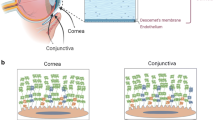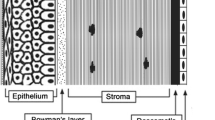Abstract
Understanding the cellular and molecular mechanisms of the corneal tissue and translating them into effective therapies requires organotypic culture systems that can better model the physiological conditions of the front of the eye. Human corneal in vitro models currently exist, however, the lack of tear replenishment limits corneal in vitro models’ ability to accurately simulate the physiological environment of the human cornea. The tear replenishment system (TRS), a micro-fluidic device, was developed to mimic the in vivo tear replenishment in the human eye in an in vitro corneal model. The TRS is capable of generating adjustable intermittent flow from 0.1 µL in every cycle. The TRS is a sterilizable device that is designed to fit standard 6-well cell culture plates. Experiments with the corneal models demonstrated that exposure to the TRS did not damage the integrity of the stratified cell culture. Contact lenses “worn” by the in vitro corneal model also remained moist at all times and the cytotoxicity of BAK could also be verified using this model. These in vitro results confirmed that the TRS presents novel avenues to assess lens-solution biocompatibility and drug delivery systems in a physiologically relevant milieu.





Similar content being viewed by others
References
Baca, J. T., D. N. Finegold, and S. A. Asher. Tear glucose analysis for the noninvasive detection and monitoring of diabetes mellitus. Ocul. Surf. 5:280–293, 2007.
Baudouin, C., A. Labbe, H. Liang, A. Pauly, and F. Brignole-Baudouin. Preservatives in eyedrops: the good, the bad and the ugly. Prog. Retin. Eye Res. 29:312–334, 2010.
Castro-Munozledo, F. Corneal epithelial cell cultures as a tool for research, drug screening and testing. Exp. Eye Res. 86:459–469, 2008.
Cavet, M. E., K. L. Harrington, K. R. Vandermeid, K. W. Ward, and J. Z. Zhang. In vitro biocompatibility assessment of multipurpose contact lens solutions: effects on human corneal epithelial viability and barrier function. Contact Lens Anterior Eye 35:163–170, 2012.
Cavet, M. E., K. R. VanDerMeid, K. L. Harrington, R. Tchao, K. W. Ward, and J. Z. Zhang. Effect of a novel multipurpose contact lens solution on human corneal epithelial barrier function. Contact Lens Anterior Eye 33(Suppl 1):S18–S23, 2010.
Chalmers, R. L., L. Keay, J. McNally, and J. Kern. Multicenter case-control study of the role of lens materials and care products on the development of corneal infiltrates. Optom. Vis. Sci. 89:316–325, 2012.
Chalmers, R. L., H. Wagner, G. L. Mitchell, D. Y. Lam, B. T. Kinoshita, M. E. Jansen, et al. Age and other risk factors for corneal infiltrative and inflammatory events in young soft contact lens wearers from the Contact Lens Assessment in Youth (CLAY) study. Investig. Ophthalmol. Vis. Sci. 52:6690–6696, 2011.
Chu, M., T. Shirai, D. Takahashi, T. Arakawa, H. Kudo, K. Sano, et al. Biomedical soft contact-lens sensor for in situ ocular biomonitoring of tear contents. Biomed. Microdev. 13:603–611, 2011.
Debbasch, C., C. Ebenhahn, N. Dami, M. Pericoi, C. Van den Berghe, M. Cottin, et al. Eye irritation of low-irritant cosmetic formulations: correlation of in vitro results with clinical data and product composition. Food Chem. Toxicol. 43:155–165, 2005.
Geerling, G., J. T. Daniels, J. K. Dart, I. A. Cree, and P. T. Khaw. Toxicity of natural tear substitutes in a fully defined culture model of human corneal epithelial cells. Investig. Ophthalmol. Vis. Sci. 42:948–956, 2001.
Gorbet, M. B., N. C. Tanti, B. Crockett, L. Mansour, and L. Jones. Effect of contact lens material on cytotoxicity potential of multipurpose solutions using human corneal epithelial cells. Mol. Vis. 17:3458–3467, 2011.
Gorbet, M. B., N. C. Tanti, L. Jones, and H. Sheardown. Corneal epithelial cell biocompatibility to silicone hydrogel and conventional hydrogel contact lens packaging solutions. Mol. Vis. 16:272–282, 2010.
Griffith, M. (inventor). Artificial cornea. USA patent number 6645715, 2003.
Hornof, M., E. Toropainen, and A. Urtti. Cell culture models of the ocular barriers. Eur. J. Pharm. Biopharm. 60:207–225, 2005.
Hui, A., A. Boone, and L. Jones. Uptake and release of ciprofloxacin–HCl from conventional and silicone hydrogel contact lens materials. Eye Contact Lens 34:266–271, 2008.
Jacob, J. Biomaterials: contact lenses. In: Biomaterials science: an introduction to materials in medicine3rd, edited by B. D. Ratner, A. S. Hoffman, F. J. Schoen, and J. E. Lemons. New York: Elsevier, 2013, pp. 909–917.
Keay L, Stapleton F, Schein O. Epidemiology of contact lens-related inflammation and microbial keratitis: a 20-year perspective. Eye Contact Lens 33:346–353, discussion 62–63, 2007.
Klyce, S. D. Electrical profiles in the corneal epithelium. J. Physiol. 226:407–429, 1972.
Lefebvre, A. H. Atomization and sprays. New York: Hemisphere Press, 1989.
Lehmann, D. M., and M. E. Richardson. Impact of assay selection and study design on the outcome of cytotoxicity testing of medical devices: the case of multi-purpose vision care solutions. Toxicol. In Vitro 24:1306–1313, 2010.
Lim, M. J., R. K. Hurst, B. J. Konynenbelt, and J. L. Ubels. Cytotoxicity testing of multipurpose contact lens solutions using monolayer and stratified cultures of human corneal epithelial cells. Eye Contact Lens 35:287–296, 2009.
Lorentz, H., M. Heynen, D. Trieu, S. J. Hagedorn, and L. Jones. The impact of tear film components on in vitro lipid uptake. Optom. Vis. Sci. 89:856–867, 2012.
Mansouri, K., F. A. Medeiros, A. Tafreshi, and R. N. Weinreb. Continuous 24-hour monitoring of intraocular pressure patterns with a contact lens sensor: safety, tolerability, and reproducibility in patients with glaucoma. Arch. Ophthalmol. 130:1534–1539, 2012.
Mishima, S., A. Gasset, S. D. Klyce, Jr., and J. L. Baum. Determination of tear volume and tear flow. Investig. Ophthalmol. Vis. Sci. 5:264–276, 1966.
Mitra, A. Ophthalmic drug delivery systems (2nd ed.). New York: Informa Healthcare, 2003.
Mohammadi, S., L. Jones, and M. Gorbet. Investigation of glaucoma drug-release from contact lens materials using in vitro cell models. Investig. Ophthalmol. Vis. Sci. 53:E-Abstract 5471, 2013.
Morgan, P. B., N. Efron, M. Helland, M. Itoi, D. Jones, J. J. Nichols, et al. Twenty first century trends in silicone hydrogel contact lens fitting: an international perspective. Contact Lens Anterior Eye 33:196–198, 2010.
Mowrey-McKee, M., A. Sills, and A. Wright. Comparative cytotoxicity potential of soft contact lens care regimens. CLAO J. 28:160–164, 2002.
Pauly, A., M. Meloni, F. Brignole-Baudouin, J. M. Warnet, and C. Baudouin. Multiple endpoint analysis of the 3D-reconstituted corneal epithelium after treatment with benzalkonium chloride: early detection of toxic damage. Investig. Ophthalmol. Vis. Sci. 50:1644–1652, 2009.
Postnikoff, C., R. Pintwala, S. Williams, A. Wright, D. Hileeto, and M. Gorbet. Development of a curved, stratified, in vitro model for assessment of ocular biocompatibility. PLoS ONE 9(5):e96448, 2014.
Powell, C. H., J. M. Lally, L. D. Hoong, and S. W. Huth. Lipophilic vs. hydrodynamic modes of uptake and release by contact lenses of active entities used in multipurpose solutions. Contact Lens Anterior Eye 33:9–18, 2010.
Reichl, S., J. Bednarz, and C. C. Muller-Goymann. Human corneal equivalent as cell culture model for in vitro drug permeation studies. Br. J. Ophthalmol. 88:560–565, 2004.
Reichl, S., C. Kolln, M. Hahne, and J. Verstraelen. In vitro cell culture models to study the corneal drug absorption. Expert Opin. Drug Metab. Toxicol. 7:559–578, 2011.
Sanchez, I., V. Laukhin, A. Moya, R. Martin, F. Ussa, E. Laukhina, et al. Prototype of a nanostructured sensing contact lens for noninvasive intraocular pressure monitoring. Investig. Ophthalmol. Vis. Sci. 52:8310–8315, 2011.
Sjoquist, B., and J. Stjernschantz. Ocular and systemic pharmacokinetics of latanoprost in humans. Surv. Ophthalmol. 47(Suppl 1):S6–S12, 2002.
Soluri, A., A. Hui, and L. Jones. Delivery of ketotifen fumarate by commercial contact lens materials. Optom. Vis. Sci. 89:1140–1149, 2012.
Tiffany, J. M. The viscosity of human tears. Int. Ophthalmol. 15:371–376, 1991.
Tiffany, J. M., N. Winter, and G. Bliss. Tear film stability and tear surface tension. Curr. Eye Res. 8:507–515, 1989.
Whitson, J. T., and W. M. Petroll. Corneal epithelial cell viability following exposure to ophthalmic solutions containing preservatives and/or antihypertensive agents. Adv. Ther. 29:874–888, 2012.
Xiang, C. D., M. Batugo, D. C. Gale, T. Zhang, J. Ye, C. Li, et al. Characterization of human corneal epithelial cell model as a surrogate for corneal permeability assessment: metabolism and transport. Drug Metab. Dispos. 37:992–998, 2009.
Yao, H., A. J. Shum, M. Cowan, I. Lahdesmaki, and B. A. Parviz. A contact lens with embedded sensor for monitoring tear glucose level. Biosens. Bioelectron. 26:3290–3296, 2011.
York, M., and W. Steiling. A critical review of the assessment of eye irritation potential using the Draize rabbit eye test. J. Appl. Toxicol. 18:233–240, 1998.
Acknowledgments
The funding for this project was provided by the Natural Sciences and Engineering Research Council of Canada and CibaVision (now Alcon). Authors also would like to thank Jason Benninger for his technical assistance in the manufacturing of the microfluidics parts and Christopher Amos from CIBA Vision for fruitful discussion related to the development of this in vitro model.
Conflict of interest
Ann M. Wright is an employee of Alcon (formerly CIBA Vision). In the past 4 years, the corresponding author (MG) has received funding from CIBA Vision/Alcon and Johnson & Johnson.
Author information
Authors and Affiliations
Corresponding author
Additional information
Associate Editor Estefanía Peña oversaw the review of this article.
Rights and permissions
About this article
Cite this article
Mohammadi, S., Postnikoff, C., Wright, A.M. et al. Design and Development of an In Vitro Tear Replenishment System. Ann Biomed Eng 42, 1923–1931 (2014). https://doi.org/10.1007/s10439-014-1045-1
Received:
Accepted:
Published:
Issue Date:
DOI: https://doi.org/10.1007/s10439-014-1045-1




